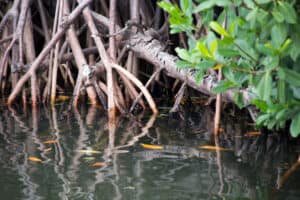What Is A Mangrove Forest?
Mangrove trees come in roughly 80 different species. All of these trees grow in low-oxygen soils where fine sediments can build up due to slow-moving waves. Due to its inability to tolerate freezing conditions, mangrove forests can only be found around the equator in tropical and subtropical latitudes.
The dense tangle of prop roots that make the trees appear to be standing on stilts above the water distinguishes many mangrove forests from other forests. Because of this tangle of roots, the trees are able to withstand the regular rise and fall of the tides, which means that most mangroves are flooded at least twice a day. Tidal waters are also slowed by the roots, causing sediments to settle out of the water and build up on the muddy bottom.
Storm surges, currents, waves, and tides all cause erosion along the shore, yet mangrove trees help to stabilize it. Mangrove forests are especially attractive to fish and other species looking for food and protection from predators because of their sophisticated root system

Mangrove Forest in Suriname
Suriname’s coastal region is large and low-lying, making it particularly vulnerable to climate-related sea level rise in the next decades. Human intervention has turned mangrove regions to agricultural land, fishing ponds, and communities at the Weg naar Zee resort in the district of Wanica, Suriname.
Because of the loss of mangroves’ stabilizing effect, the coast has become vulnerable to flooding and erosion, losing up to 27 meters of land in a year, displacing local residents and destroying livelihoods. Flooding and soil degradation threaten the local population of about 3,000 people, as well as their fisheries, farms, and religious and cultural sites.
Professor Naipal of Suriname’s Anton de Kom University began his Building With Nature Project at Weg naar Zee in 2015. This is currently the most vulnerable neighborhood in South America and the Caribbean due to rising sea levels. To capture silt and replant mangroves, wooden, water-permeable dams are being created. This project is a great example of how to adapt to climate change.
Along with the Amazon rainforest, Mangrove ecosystems store a great amount of carbon. While Professor Naipal is working with nature along the coast, Green Child also works on mitigating climate change through the protection of the Amazon rainforest. Together with the Amazon Conservation Team and Indigenous and tribal communities we work with nature to provide you delicious natural food.
Why do #MangroveTreesMatter?
- Mangroves are biodiversity hotspots because they are home to a diverse range of species. Fish and shellfish, migratory birds, and sea turtles use them for nesting and breeding. Several of these animal species are threatened with extinction. Mangrove forests are responsible for an estimated 80% of global fish capture, either directly or indirectly.
- Many fishermen and farmers in rural areas rely on their natural surroundings to feed their families. Healthy mangrove ecosystems means fishing from healthy fisheries, and farming from healthy land. Check out this film on mangroves and livelihoods from Friends of the Earth.
- Mangroves are necessary for water quality preservation. Sediments, heavy metals, and other contaminants are filtered and trapped by their extensive network of roots and surrounding vegetation. This ability to keep sediments coming from upstream protects vulnerable ecosystems below, such as coral reefs and sea grass beds, and prevents contamination of downstream streams.
- Coastal defense.Coastal communities rely on mangroves as their first line of defense. They safeguard coastal areas from increasing storm surge, flooding, and hurricanes by slowing erosion and providing natural barriers. Mangrove forests provide natural protection for populations who are exposed to rising sea levels and increasingly severe and frequent weather events as a result of climate change.
- Carbon storage.Mangroves sequester two to four times more carbon than mature tropical forests and store three to five times more carbon per equal area than tropical forests such as the Amazon rainforest. This means that protecting and restoring mangroves is critical in the fight against climate change, the global warming caused by increased carbon emissions, which is already wreaking havoc on communities around the world. At the same time, as sea level rise pushes habitats inland, mangroves are vulnerable to climate change.
- Communities have always used mangrove wood and other extracts for both building and medicinal uses, in addition to consuming fish and shellfish from the mangroves. Their potential as a source of novel biological materials including antibacterial chemicals and pest-resistance genes is yet mostly unknown.
Still not convinced? Maybe this will help:
